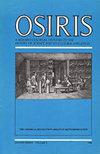Patenting Personalized Medicine
IF 1
3区 哲学
Q2 HISTORY & PHILOSOPHY OF SCIENCE
引用次数: 4
Abstract
The histories of patent law and medical practice in the United States have intersected in various ways over the past 150 years, beginning with the professional campaign against “patent medicines” in the late nineteenth century, and culminating, for now, in attempts to patent the diagnostic procedures discussed in this article. The patenting of diagnostic procedures provokes a set of fundamental questions about the episteme of patent law. These questions are not new. They emerged at the very origins of patent jurisprudence, centered on the question of what distinguished an invention from a law of nature, and this question of patentability has persistently reemerged over the past century in the contexts of plant breeding, biotechnology, and now diagnostic medicine. So far, the question has been addressed in terms that imagine the invention as a machine, understood in the figurative sense of a transformative organization of forces and elements. But diagnostic procedures, because they address the body informationally, as a system based on the recursive patterning of signals rather than a linear transformation of inputs into outputs, stretch the figure of the machine to the point at which it ceases to be effective. How then should one define and delimit invention?专利个性化医疗
在过去的150年里,美国专利法和医疗实践的历史以各种方式交织在一起,从19世纪晚期反对“专利药物”的专业运动开始,到现在,本文讨论的诊断程序试图获得专利。诊断程序的专利引发了一系列关于专利法知识的基本问题。这些问题并不新鲜。它们出现在专利法学的起源,其核心问题是如何将发明与自然法则区分开来。在过去的一个世纪里,在植物育种、生物技术和现在的诊断医学的背景下,可专利性的问题不断地重新出现。到目前为止,这个问题的解决方式是把发明想象成一台机器,从一种力量和元素的变革性组织的比喻意义上理解。但是诊断程序,因为它们处理身体的信息,作为一个系统的递归模式的信号,而不是一个线性转换的输入到输出,拉伸机器的图形到一个点,它不再有效。那么,人们应该如何定义和界定发明呢?
本文章由计算机程序翻译,如有差异,请以英文原文为准。
求助全文
约1分钟内获得全文
求助全文
来源期刊

Osiris
管理科学-科学史与科学哲学
CiteScore
1.10
自引率
0.00%
发文量
18
审稿时长
>12 weeks
期刊介绍:
Founded in 1936 by George Sarton, and relaunched by the History of Science Society in 1985, Osiris is an annual thematic journal that highlights research on significant themes in the history of science. Recent volumes have included Scientific Masculinities, History of Science and the Emotions, and Data Histories.
 求助内容:
求助内容: 应助结果提醒方式:
应助结果提醒方式:


